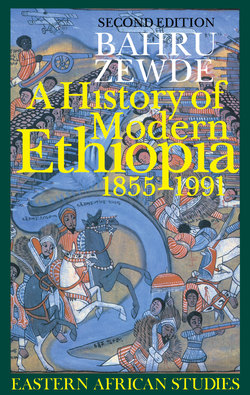Читать книгу A History of Modern Ethiopia, 1855–1991 - Bahru Zewde - Страница 8
На сайте Литреса книга снята с продажи.
ОглавлениеIllustrations
Cover: A traditional painting depicting the Battle of Anchem
Prelims: A session of Ethiopia’s first parliament being addressed by Emperor Hayla-Sellase I, 1935
1.1. The city of Harar as it appeared in the first decade of the twentieth century
2.1. Emperor Tewodros II’s mortar ‘Sebastopol’ being dragged up the slopes of Maqdala
2.2. The prisoners of Emperor Tewodros II
2.3. A sketch of Dajjach Kasa Mercha, the future Emperor Yohannes IV
2.4. Negus Takla-Haymanot, hereditary ruler of Gojjam
2.5. Ras Alula Engeda, Emperor Yohannes’s governor of the Marab Melash, and implacable opponent of Italian encroachment
2.6. The port town of Massawa towards the end of the nineteenth century
2.7. Dajjach Gabra-Egziabber (Kumsa) Moroda, ruler of Leqa Naqamte
2.8. Abba Jifar II, ruler of Jimma
2.9. Emir Abdullahi, ruler of the Harar emirate
2.10. Kawa Tona, the last king of Walayta
2.11. Emperor Menilek II and some of his nobles
2.12. Tato Gaki Sherocho, the last king of Kafa
2.13. Ankobar, capital of the Shawan kings until Negus Menilek moved to Entotto and then to Addis Ababa
2.14. A view of Arada, the Addis Ababa market, 1935
2.15. Ras Mangasha Yohannes, son of Emperor Yohannes IV, and hereditary ruler of Tegre
3.1. A gabbar and his son in north-eastern Shawa
3.2. Foreign visitors receiving dergo, the provisions that peasants were compelled to supply by royal order
3.3. Dajjach Dames Nasibu, later Ras, governor of Wallaga
3.4. Ras Berru Walda-Gabr’el, Minister of War after the death of Fitawrari Habta-Giyorgis in 1926
3.5. A street scene in down-town Addis Ababa, 1935
3.6. A commemorative picture taken on the occasion of a reception in honour of a French mission, 1929
3.7. A train arriving at Dire Dawa railway station
3.8. Bank of Abyssinia, c 1910
3.9. An Ethiopian delegation to Europe, 1911
3.10. Hakim Warqenah Eshate (Dr Martin)
3.11. Naggadras Gabra-Heywat Baykadagn, a leading intellectual of the early twentieth century
3.12. Blatten Geta Heray Walda-Sellase, prolific writer, and Minister of Foreign Affairs from 1931-1936
3.13. Tafari Makonnen School at about the time of its founding in 1925
3.14. Students of an early twentieth-century school
3.15. Emperor Menilek II, r. 1889-1913
3.16. Ras Makonnen Walda-Mikael, governor of Harar, shown with the German mission to Ethiopia in 1905
3.17. Lej Iyyasu and his father Ras Mikael of Wallo
3.18. Empress Taytu Betul, wife of Emperor Menilek II
3.19. Dajjach Gabra-Sellase Barya-Gabr, ruler of Adwa, and one of the leading spokesmen against Empress Taytu in 1910
3.20. Abuna Mattewos, Egyptian archbishop of Ethiopia from 1889-1926
3.21. The quragna system, whereby plaintiff and defendant were chained together until justice was done
3.22. A leba shay, the traditional thief-detector, as he prepares to snuff out the culprit
3.23. Naggadras Hayla-Giyorgis Walda-Mikael, later Bitwaddad, Minister of Foreign Affairs and of Commerce after 1907 and de facto prime minister during the reign of Iyyasu
3.24. Empress Zawditu Menilek, r. 1916-1930
3.25. Fitawrari Habta-Giyorgis Dinagde, Minister of War from 1907-1926
3.26. Dajjach Balcha Safo, hero of the Battle of Adwa, and one of the conservative opponents of Ras Tafari Makonnen
3.27. Dajjach Abba Weqaw Berru, leader of a mutiny against Ras Tafari Makonnen in 1928
3.28. Ras Gugsa Wale, husband of Empress Zawditu, and governor of Bagemder
3.29. A traditional painting depicting the Battle of Anchem, 1930
3.30. Emperor Hayla-Sellase, r. 1930–1974
3.31. Bajerond Takla-Hawaryat Takla-Maryam, the Russian educated intellectual who drafted the 1931 Constitution
3.32. Ras Haylu Takla-Haymanot, hereditary ruler of Gojjam from 1901–1932
3.33. Dajjach Seyum Mangasha, later Ras, hereditary ruler of Tegre
3.34. Troops of the Imperial Bodyguard, 1935
4.1. Amba Aradom, where Ethiopian troops commanded by Ras Mulugeta Yeggazu were heavily defeated by the Italians in February 1936
4.2. Ras Mulugeta Yeggazu, holder of various ministerial posts and provincial governorships, one of the commanders on the northern front in 1935–1936
4.3. An Ethiopian soldier leaving for the Ogaden front bids farewell to his relatives, November 1935
4.4. Ras Abbaba Aragay, most renowned leader of the Reststance in Shawa
4.5. Ras Emeru Hayla-Sellase, commander of the Shere front in 1935–1936, and leader of the Black Lion Resistance operations in south-western Ethiopia
4.6. Ras Dasta Damtaw, commander of the southern front in 1935–1936
4.7 and 4.8. Moments before and after the attempt on the life of the Italian viceroy, Marshal Rodolfo Graziani, in Addis Ababa, 19 February 1937
4.9. Shawaragad Gadle, an undercover patriot instrumental in the storming of the Italian stronghold at Addis Alam
4.10. Dr Alamawarq Bayyana, president of the Black Lion Resistance organization
5.1. Qagnaw, the United States base at Asmara established following the Ethio-US Treaty of 1953
5.2. Pack animals competing for the runway with a DC-3 aircraft of Ethiopian Airlines
5.3. Tsahafe T’ezaz Walda-Giyorgis Walda-Yohannes, the most powerful figure under Hayla-Sellase in the period 1941-1955
5.4. Ras Bitwaddad Makonnen Endalkachaw, prime minister in the period 1943-1957
5.5. Tsahafe T’ezaz Aklilu Habta-Wald, prime minister from 1961-1974
5.6. Major-General Mulugeta Buli, commander-in-chief of the Imperial Bodyguard from 1941-1955
5.7. The leaders of the abortive coup d’etat of 1960, Brigadier General Mangestu Neway and Garmame Neway
5.8. A student demonstration against the Hayla-Sellase regime
6.1. The building in the Fourth Division headquarters where the Darg was born
6.2. Emperor Hayla-Sellase soon after his deposition and the Volkswagen ‘beetle’ that took him to his place of detention
6.3. Lt. General Aman Mikael Andom responding to the cheers of the Eritrean public during a rally at the Asmara stadium
6.4. Zamach students engaged in one of their daily chores, fetching water
6.5. Partial view of the huge public demonstration that hailed the rural land reform proclamation
6.6. Mangestu Hayla-Mariam playing the meek subaltern
6.7. Three of the highest officials of the Darg: Mangestu, Atnafu and Sisay
6.8. Fighters of the Tegray People’s Liberation Front
